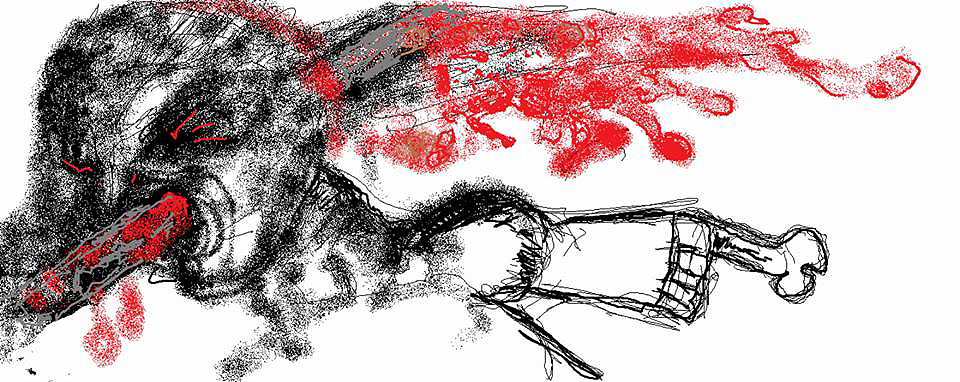.
Bob Shell: Letters From Prison #35
.
Letters by Bob Shell, Copyright 2019
.
Photography by Anthony Colagreco, Copyright 2019
.
I have often been asked why I had my office/studio in Radford, VA, not exactly the center of culture..
In the mid 70s, after the near collapse of the US economy (caused by the infamous Arab oil embargo and other economic factors) wrecked my first camera shop, I worked for a year for Woolco Department Stores managing the camera department in one of their Roanoke stores. I didn’t like that job, because department managers didn’t really manage anything, and quit to take a job with Ritz camera in Blacksburg. When that didn’t work out (my selling style was to spend the time with the customer to find out what that person needed to buy to accomplish what they wanted to do, and sell them that. The regional manager said I was spending too much time with the customers!), I found myself working in the photo lab at Virginia Tech, where I’d gone to school. We developed and printed film shot by the two staff photographers, and when both of them were busy, I’d occasionally be asked to go out and shoot a “grip and grin” photo of the university President shaking hands with some visiting dignitary. But I wanted to be the photographer, not a lab rat in the basement, so after a year or so at this I left and took a job with Gentry Studio in Blacksburg. They were a combo of photo studio and camera shop, the perfect job for me.
I worked there for several years, honing my own photography skills in their studio after hours. I liked working there very much, but always had the itch to do my own thing. After all, even the best boss is still your boss, and I never liked working for other people. Gentry Studios had three locations, Salem, Blacksburg, and Radford, all long established. The owner decided to close the Radford studio, so I took the leap and took it over. I changed the sign to Shell Studio and expanded the camera shop portion. This, as I recall, was in 1980, and the rent on the large studio location was $ 300 a month! Amazing, eh? But at times I had trouble coming up with that money. I inherited the job of photographing the sororities at Radford University and some other school business, plus selling all the materials required for the photography courses. This, plus portraits and some commercial work kept me going for a while, but money was tight. To pick up some extra income I began writing for a relatively new photography publication initially called Shutterbug Ads, a buy-sell-swap newspaper for photographers. Initially there was not much editorial content, and that was often poor in quality, but the owner wanted to improve the quality and become more of a mainstream magazine. When I first wrote for them they were printed tabloid size on yellow paper, and writers were paid in copies.
Parallel to this I had started a photographic equipment import and distribution operation. I had almost accidentally stumbled upon Enna Werk, a small German optical company in Munich that had just lost its US distributor. So I began importing and wholesaling their products, primarily camera lenses, slide viewers, slide projectors, and the Ennascop opaque projectors. After a year I broadened my product lines to include Fisher tripods and video lights from Italy, COIL aspheric magnifiers from England, and Lamborghini camera bags and sunglasses. These additional product lines resulted from meeting people at photokina in 1980, which I also covered for Shutterbug. For ten years I ran this business in parallel to acting as Shutterbug’s Technical Editor. By 1990 it had become just too much to do all of this, so I sold the import/distribution business. Shutterbug had by then transitioned to being a real magazine with ever-growing subscription list, distribution to booksellers, grocery stores, Wal-Mart, etc., and they offered me the job as Editor at a payment rate I could live on. As I have said before, though, I was never an employee of Shutterbug. I contracted to supply editorial services at a fixed monthly rate. This allowed me the freedom to set my own office hours, stay away from office politics, and take on noncompeting projects, like writing books. By the late 80s I was writing several books a year as well as writing for Photo Industry Reporter and some other noncompeting publications. Since I could do my work from anywhere, I stayed on in the Radford studio location, at 202 Third Avenue, right in downtown Radford. I probably would have stayed there indefinitely, but the roof leaked and the landlord refused to fix it. After two studio floods my insurance company said they would not pay for any more water damage, so I was forced to move. Luckily a great location became available, a former pharmacy measuring about 35 X 80 feet at 239 West Main Street, just a short distance from the police department. I kept my studio there from 1992 until 2007, fifteen years. So I had studios in Radford, on major commercial streets, for 20+ years, but when the police came to my studio after Marion’s death the detectives said they didn’t know I was in town! Some detecting!!
I wanted a big studio space, and the new location was ideal, since I had begun conducting studio workshops for groups of photographers. The monthly rent there started at $ 500 a month, and by 2007 had only gone up to $ 525! And that included a reserved parking space right by the back door. The rent also included heat in the winter. Amazing, and one of the main reasons I stayed in Radford all those years.
Anyway, that’s the story of why I was in Radford, somewhat abridged. I’d probably still be there, doing my photography, writing for books, magazines and websites, and generally enjoying life if the police hadn’t foolishly blamed me for Marion’s death. Their simple-minded nonsense destroyed me at the peak of my career. The plain fact, never disputed by anyone, is that I was not even there when Marion overdosed. When I found her unconscious, I immediately called 911 and did everything in my power to help her.
The real reason the Radford police, prosecutors, and court felt they had to destroy me was that some of my photography was frankly erotic (many Americans are terrified of open sexuality), and at the time of Marion’s death we were working on a book of erotica for a German publisher. The book was ultimately published as Erotic Bondage: Art of Rope by Goliath, first in their MixOfPix series. There is nothing pornographic about this book; no penetration, the photos are no more revealing than Playboy and far less revealing than Penthouse. We even Photoshopped some photos because we wanted to sell the book in most countries of the world, and put the text in English, German, French, and Spanish, for that reason as well. The book was published under my pseudonym Edward Lee, a pseudonym I’d used often since at least1993 (I don’t really remember when I first used it; it’s actually my two middle names. Over the course of my career I’ve used a number of pseudonyms for a variety of reasons. Many writers have done so. My friend Don Sutherland used something like 16 or 17 different pseudonyms.)
At my trial the prosecutor waved a copy of the book around at every opportunity, shoving it at my witnesses’ faces – “Have you seen THIS?”. He always seemed surprised when they answered, “Yes, Bob gave me a copy.” He was offended that they weren’t offended! None of my friends and former models found the book objectionable.
I just managed to keep my business going doing the 4+ years I was out on bail awaiting trial. I wrote four books, numerous magazine articles, held workshops, had a gallery show of my photographs in Chicago (but couldn’t go to it!), did my own photography, and generally tried to live a normal life during that time. But the prosecution was determined to convict me, and used false evidence and practically every other dirty trick in the book to. convince the jury that I was a scumbag who regularly drugged and raped my models, even though they couldn’t locate a single former model with anything negative to say about me. Not a one! And they looked for more than four years. As a lawyer I know said, if that had been true, surely someone would have come forward.
I’m almost tired of repeating that I am a totally innocent man destroyed by a corrupt political system because I dared to be different. They sentenced me to 32 1/2 years, when the Virginia sentencing guidelines recommended a maximum sentence of three years! The Virginia Dept. of Corrections classifies me as a “numerical lifer,” which means that even though I don’t have a life sentence I’m unlikely to live long enough to get out. That’s really depressing!
.
About The Author: Bob Shell is a professional photographer, author and former editor in chief of Shutterbug Magazine. He is currently serving a 35 year sentence for involuntary manslaughter for the death of Marion Franklin, one of his former models. Shell was recently moved from Pocahontas State Correctional Center, Pocahontas, Virginia to River North Correctional Center 329 Dellbrook Lane Independence, VA 24348. Mr. Shell continues to claim his innocence. He is serving the 11th year of his sentence. To read more letters from prison by Bob Shell, click here: http://tonyward.com/bob-shell-wherefore-blog/




































